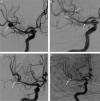A comparison of Atlas and Leo Baby stents-assisted coiling of intracranial aneurysms with small parent vessels
- PMID: 37554899
- PMCID: PMC10406018
- DOI: 10.1097/MS9.0000000000000938
A comparison of Atlas and Leo Baby stents-assisted coiling of intracranial aneurysms with small parent vessels
Abstract
Some studies have reported the efficacy and safety of the Atlas stent and the Leo Baby stent-assisted coiling (SAC) of intracranial aneurysms arising from small cerebral vessels. The authors aimed to compare the clinical performance of the Atlas and the Leo Baby stents in small parent arteries.
Methods and materials: Between January 2019 and November 2022, 56 patients at our centre were treated using either Atlas or Leo Baby SAC of intracranial aneurysms arising from small parent vessels (<2 mm). The clinical and angiographic imaging data of the two cohorts were retrospectively collected and comparatively analyzed.
Results: A total of 56 patients were included in this study. Thirty-two patients were treated with the Atlas SAC, and 24 patients were treated with the Leo Baby SAC. The mean age of the Atlas stent cohort was older, and the mean aneurysm size was smaller than the Leo Baby stent. The immediate complete occlusion rate was 68.6% in the Atlas stent cohort and 62.5% in the Leo Baby stent cohort. The mean angiographic follow-up time for Atlas stent cohort was 8.9±2.5 months, and the final aneurysm complete occlusion rate was 81.0%. The mean follow-up time for Leo Baby stent cohort was 18.9±6.0 months, and the final aneurysm complete occlusion rate was 83.3%.
Conclusions: At the final follow-up, the Atlas or the Leo baby stent SAC of intracranial aneurysms with small parent vessels resulted in favourable angiographic results and clinical outcomes, with a low rate of associated complications.
Keywords: aneurysm occlusion rate; atlas stents; intracranial aneurysms; leo baby stents; small vessels.
Copyright © 2023 The Author(s). Published by Wolters Kluwer Health, Inc.
Conflict of interest statement
The authors declare that there are no potential conflicts of interests.
Figures


References
-
- Zhang J, Lv X, Jiang C, et al. . Endovascular treatment of cerebral aneurysms with the use of stents in small cerebral vessels. Neurol Res 2010;32:119–122. - PubMed
-
- Aydin K, Balci S, Sencer S, et al. . Y-stent-assisted coiling with low-profile neuroform Atlas stents for endovascular treatment of wide-necked complex intracranial bifurcation aneurysms. Neurosurgery 2020;87:744–753. - PubMed
LinkOut - more resources
Full Text Sources
